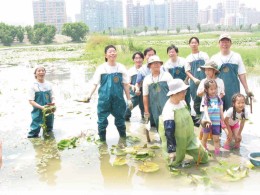Pheasant- tailed Jacana's Newest Happy Land- Jhouzih Wetland Park 水雉的新樂園──洲仔濕地公園
In the city of Kaohsiung, there is now another environmental wetland park!
 After the construction of Taiwan's High- Speed Railway has been completed and travel to the area of Zuoying is possibly, Kaohsiung City plans to combine the Dingjin network of intersecting roads, with Fuodao number ten and high- speed roads, located in the urban area of Kaohsiung's land transportation. Kaohsiung City Government has made tremendous efforts in the reconstruction of sightseeing areas at Zuoying Lotus Lake. Furthermore, the city government has also been gathering advice and opinions from various environmental groups and local residents. The final goal is to build a new sightseeing spot at the old city of Zuoying by transforming the Lotus Lake and its adjacent undeveloped park into a Jhouzih Wetland Park.
After the construction of Taiwan's High- Speed Railway has been completed and travel to the area of Zuoying is possibly, Kaohsiung City plans to combine the Dingjin network of intersecting roads, with Fuodao number ten and high- speed roads, located in the urban area of Kaohsiung's land transportation. Kaohsiung City Government has made tremendous efforts in the reconstruction of sightseeing areas at Zuoying Lotus Lake. Furthermore, the city government has also been gathering advice and opinions from various environmental groups and local residents. The final goal is to build a new sightseeing spot at the old city of Zuoying by transforming the Lotus Lake and its adjacent undeveloped park into a Jhouzih Wetland Park.
The existing Jhouzih Wetland Park is broad and capacious with a total area of about ten 2hm. This park constitutes three 2hm of water caltrop farmland as well as a lotus lake, all belonging to the hydro-plant ecosystem. In order to build a strong foundation for reviving our ecosystem, the municipal government has been busy landscaping the soil, renovating lands, fixing hillsides, draining out excess water and imbedding different plants within this area at Jhouzih. Through these processes, a complete wetland environment will be created.
The Taiwan Wetland Protection Organization adopted the Jhouzih Wetland Park in May, 2003. During the last two years, the organization has conducted different plans a satisfactory creation of a wetland environment; for pheaseant-tailed Jacana to migrate back home, is a plan that has already been in progress for a year. The land was originally undeveloped, but it is now cultivated with various kinds of hydro-plants. This will help to create a desirable natural habitat which will mature with time. The indigenous water birds have already increased in number and 40 to 80 different kinds can now be found on this land. Despite the migratory habits of the birds over winter, they are still able to add life to the wetland park.
The Executive Director of the Wetland Protection, Hsieh A-sun, stated that after the plans for renovating the environment on the Jhouzih Wetland Park have been completed, it will contain ponds, lower grasslands and forests. Signs of the existence of many unusual kinds of birds have already appeared due to increased food resources. For example, this wetland now includes both water birds and land birds, such as Taiwan's Blue Magpie and Hill Partridge, as well as the Ring-necked Pheasant, the Gray Heron, Egrets, Black-winged Stilts and little wild ducks, amongst others.
One of these special birds, the Pheasant-tailed Jacana, has the nickname of " Ling-po Fairy". It is considered to be the second most rare species of bird in the world. An English Ornithologist, Professor Swinhole, is documented as having discovered the Pheasant-tailed Jacana in a pond in Kaohsiung in April, 1864. This is the first recorded discovery of the Jacana, throughout the world.
The Pheasant-tailed Jacana likes to build its nest on water caltrops or lotus leaves. In recent times, enormous areas of wetland have been over-developed, causing this bird to become almost extinct. In order to save these unusual birds, the Wetland Organization is promoting a plan called, "Pheasant-tailed Jacana migrates back to their home" in Jhouzih Wetland Park. This plan is going to be used as an example in the protection of the habitat. This lake's coverage of lotus and water caltrops is now complete; moorhens, which have similar behavior pattern to Pheasant-tailed Jacanas have started to appear in this area and have already built nests. The next goal is to wait for the presence of the " Ling-po Fairy", which will beautify the area, as will the different butterflies and birds. This park is going to become an urbanized wetland park which will allow citizens to gain closer contact with a natural ecosystem.
高雄市區中,又多一處令人期待的生態濕地樂園!
有鑑於左營地區在高鐵完工通車後,將結合鼎金系統交流道、國道十號以及高雄都會區快速道路等,躍昇為高雄陸運之門戶,市府不僅大力改造左營蓮池潭的景觀,更集聚了環保團體觀點與在地耆老意見,將蓮池潭旁、閒置已久的公園用地,開闢成洲仔濕地公園,成為左營舊城及蓮池潭周邊的新地景。
洲仔濕地公園幅員遼闊,佔地約10公頃,園區內保留3公頃菱角田與荷花園等水生植物生態,同時施以填土、整地、修坡、排水與植栽綠化工程,營造出完整的濕地環境,作為復育生態的基礎。
自2003年5月起,園區由中華民國濕地保護聯盟認養兩年,在豐富的濕地生態上推展「水雉返鄉行動」;計畫進行一年多來,原本的荒地,已充滿各種的水生植物,建構了相當良好的棲地環境,而環境的豐富度增加,前來此地棲息的水鳥,也從四十多種,增加為八十多種,不論是來度冬或越冬,都為濕地公園增添了無比生命力。
濕地保護聯盟執行長阿善先生表示,洲仔濕地公園環境復育完成後,有水塘、有低草原與樹林,食物來源充沛,目前已出現許多罕見鳥類的蹤跡,像是台灣藍鵲、竹雞、環頸雉、蒼鷺、鶿鷺、野生小水鴨、高蹺......等等,水鳥、陸鳥都有。
在這些稀有鳥類當中,有「凌波仙子」之稱的水雉,更是屬於第二級珍貴稀有保育類留鳥。有文獻記載,英國博物學家史溫侯(Swinhoe)於一八六四年四月在高雄的大水塘發現水雉,這是台灣水雉最早被發現的紀錄。
由於水雉是在菱角、荷葉之類的浮葉植物上築巢,近年由於濕地被大量開發,導致水雉瀕臨消失的危機,因此濕地聯盟在洲仔濕地公園推動「水雉返鄉行動」,藉著拯救稀有生物,作為生態復育的指標。目前蓮花與菱角在水塘上的覆蓋率已經完成,與水雉有相同習性的紅冠水雞也已經在此出現、築巢,接下來就等著美麗的凌波仙子出現,屆時群蝶飛舞,百鳥來朝之美景,將為市民創造出一處既可親水、又可觀察自然生態的都市型濕地公園。